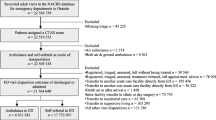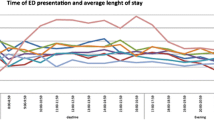Abstract
To determine if a physician in triage (PIT) improves Emergency Department (ED) patient flow in a community teaching hospital. This is an interventional study comparing patient flow parameters for the 3-month periods before and after implementation of a PIT model. During the interventional time an additional attending physician was assigned to triage from 1 p.m. to 9 p.m. daily. Outcome measures were median time to attending physician evaluation, median length of stay (LOS), number of patients who left without being seen (LWBS), and total time and number of days on ambulance diversion. Non-normally distributed values were compared with the Wilcoxon rank sum test. Proportions were compared with Chi-square test. Outcome measures were available for 17,631 patients, of whom 8,620 were seen before the initiation of PIT, and 9,011 were seen after PIT was implemented. For all patients, the median time from registration to attending physician evaluation was reduced by 36 min (1:41 to 1:05, p < 0.01) while the median LOS for all patients was reduced by 12 min (3:51 to 3:39, p < 0.01) after the intervention. Both the number of days on diversion (24 vs. 9 days) and total time on diversion (68 h 25 min vs. 26 h 7 min) were decreased, p < 0.01. Finally, there was a slight reduction in the number of patients who LWBS from 1.5 to 1.3 %, but this was not statistically significant (p = 0.36). Patient flow parameters in a community teaching hospital were modestly improved as a result of PIT implementation.
Similar content being viewed by others
References
Derlet R, Richards J, Kravitz R (2001) Frequent overcrowding in U.S. emergency departments. Acad Emerg Med 8:151–155
Bernstein SL, Asplin BR (2006) ED crowding: old problems, new solutions. Emerg Med Clin N Am 24:821–837
Derlet RW, Richards JR (2000) Overcrowding in the nation’s emergency departments: complex causes and disturbing effects. Ann Emerg Med 35:63–68
Bernstein SL, Aronsky D, Duseja R (2009) The effect of emergency department crowding on clinically oriented outcomes. Acad Emerg Med 16(1):1–10
Richardson DR (2006) Increase in patient mortality at 10 days associated with emergency department overcrowding. Med J Aust 184:213–216
Sprivulis PC, Da Silva JA, Jacobs IG et al (2006) The association between hospital overcrowding and mortality among patients admitted via Western Australian emergency departments. Med J Aust 184:208–212
Baker DW, Stevens CD, Brook RH (1991) Patients who leave a public hospital emergency department without being seen by a physician. Causes and consequences. JAMA 266:1085–1090
Stock LM, Bradley GE, Lewis RJ et al (1994) Patients who leave emergency departments without being seen by a physician: magnitude of the problem in Los Angeles County. Ann Emerg Med 23:294–298
Pines JM, Localio AR, Hollander JE et al (2007) The impact of emergency department crowding measures on time to antibiotics for patients with community-acquired pneumonia. Ann Emerg Med 50:510–516
Fee C, Weber EJ, Maak CA et al (2007) Effect of emergency department crowding on time to antibiotics in patients admitted with community-acquired pneumonia. Ann Emerg Med 50:501–509
Pines JM, Hollander JE, Localio AR et al (2006) The association between emergency department crowding and hospital performance on antibiotic timing for pneumonia and percutaneous intervention for myocardial infarction. Acad Emerg Med 13:873–878
Schull MJ, Morrison LJ, Vermeulen M et al (2003) Emergency department overcrowding and ambulance transport delays for patients with chest pain. CMAJ 168:277–283
Schull MJ, Vermeulen M, Slaughter G et al (2004) Emergency department crowding and thrombolysis delays in acute myocardial infarction. Ann Emerg Med 44:577–585
Dierks DB, Roe MT, Chen AY et al (2007) Prolonged emergency department stays of non-ST-segment-elevation myocardial infarction patients are associated with worse adherence to the American College of Cardiology/American Heart Association guidelines for management and increased adverse events. Ann Emerg Med 50:489–496
Pines JM, Hollander JE (2008) Emergency department crowding is associated with poor pain care for patients with severe pain. Ann Emerg Med 51:1–5
Hwang U, Richardson LD, Sonuyi TO et al (2006) The effect of emergency department crowding on the management of pain in older adults with hip fracture. J Am Geriatr Soc 54:270–275
Han JH (2010) The effect of physician in triage on emergency department length of stay. J Emerg Med 39(2):227–233
Partovi SN, Nelson BK, Bryan ED et al (2001) Faculty triage shortens emergency department length of stay. Acad Emerg Med 8:990–995
Holroyd BR, Bullard MJ, Latoszek K et al (2007) Impact of a triage liaison physician on emergency department overcrowding and throughput: a randomized controlled trial. Acad Emerg Med 14:702–708
Terris J, Leman P, O’Connor N et al (2004) Making an IMPACT on emergency department flow: improving patient processing assisted by consultant in triage. Emerg Med J 21:537–541
Subash F, Dunn F, McNicholl B et al (2004) Team triage improves emergency department efficiency. Emerg Med J 21:542–544
Choi YF, Wong TW, Lau CC (2006) Triage rapid initial assessment by doctor (TRIAD) improves waiting time and processing time of the emergency department. Emerg Med J 23:262–265
Rowe BH, Guo X, Villa-Roel C et al (2011) The role of triage liaison physicians on mitigating overcrowding in emergency departments: a systematic review. Acad Emerg Med 18(2):111–120
Massachusetts Department of Public Health Office of Emergency Preparedness. Hospital Capacity Website. https://hd.dph.state.ma.us/Login.asp
Conflict of interest
None.
Author information
Authors and Affiliations
Corresponding author
Rights and permissions
About this article
Cite this article
Imperato, J., Morris, D.S., Binder, D. et al. Physician in triage improves emergency department patient throughput. Intern Emerg Med 7, 457–462 (2012). https://doi.org/10.1007/s11739-012-0839-0
Received:
Accepted:
Published:
Issue Date:
DOI: https://doi.org/10.1007/s11739-012-0839-0




